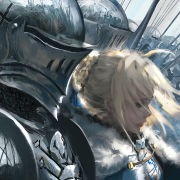|
IshmaelZarkov posted:So over the last couple of weeks I've slammed out a little game for my local group to play, given we all love cyberpunk but have different mechanical desires to what most cyberpunk-y games offer. I like the idea but making the bolded words line up (by changing where each line starts) would do wonders for readability. Using a monospaced font a) looks more techy/programmery because most console prompts/IDEs use one and b) makes it way easier to line up said bolded words.
|
|
|
|

|
| # ? Jun 10, 2024 08:27 |
|
I need to fish for some opinions before this internal dialogue gets too intense. I'm having some doubts about my core resolution system; right now, it's 2d8, and external factors (eg. cover, concealment, tactical effects) add bonus or penalty dice which cancel each other out. If you're rolling with a net bonus, you take the best set, if you're rolling with a penalty, you choose the worst. Straightforward, quick, and requires minimal arithmetic. The only concern that's bubbling up is that it's fairly opaque. A player will know that they're rolling with a better or worse chance of success, but they won't know how likely they are to actually succeed. This rankles for me, as Erebus is primarily focused on tactical combat, and having a modifier system that doesn't actually let you take calculated risks feels like a misstep. The alternative I've been considering would be moving to percentile roll under. I like d100-under because it's completely transparent; you're rolling against a 45, you have a 45% chance of success. The only problem is, it's moving back in the direction of requiring arithmetic, as all the bonus/penalty factors will need to be stacked up before a roll. Also, if I'm moving to d100, I need to codify my existing Crit and Graze mechanics for it, which would mean having thresholds on top of modifiers. Eg., you beat your target number by 30, that's a crit, if you miss by 30 or less, that's a graze. I realise that there's a spectrum of complexity here - if I'm going to percentile I'm not going for the kind of madness in, say, Warhammer d100 games, where you'll have 4-5 modifiers on every roll. Weapons don't have their own accuracy scores, just range bands, and any kind of complex action is handled through character options rather than having burst/autofire/suppression mechanics on everything. I kind of also just worry is that people just won't want to engage with something as 'old-school' as percentile. Most systems these days are either d20, 2dX or dice pools, and even if I have good reasons for my design I worry that it'll turn off potential players. Are my fears founded, or just number-nerd pedantry? Should I stick with what I've got, or consider drafting out the alternative? Zeerust fucked around with this message at 08:36 on Aug 9, 2019 |
|
|
|
What kind of dice do the modifiers add? If there's limited permutations just stick a table at the back of odds to roll at least X with the most common combinations.
|
|
|
|
It's just more d8s in either direction. If you're rolling +1 Boost, you roll 3d8 and choose the highest 2; if you've got +3 Boost and +1 Glitch, they cancel out so you're rolling with +2 boost, so 4d8 choose 2. You roll a maximum of 5d8 in either direction. I've already put a sidebar into my current beta draft explaining how each degree of Boost or Glitch affects the average (Basically +/-2, then 3, then 4). Obviously the bell curve on roll X drop Y is actually kind of wacky, but otherwise not too unpredictable.
|
|
|
|
In that case a chance to roll X or higher table would be 17 across and 13 down (or vice versa), including labels. Totally doable for a splash page for the specific odds. You do want the listed odds to be "at least X" because realistically that's what people care about.
|
|
|
|
Thanks for sheet feedback, people! I'll tidy it up and line things up after the current round of playtests.Zeerust posted:I need to fish for some opinions before this internal dialogue gets too intense. I'd personally prefer the Xd8 system. As long as you have crumched the odds and made add sure the bonuses and penalties scale in a reasonable fashion, it should be fine. I'd personally prefer it to another d% + fifteen different things to calculate system
|
|
|
|
Thanks for the advice, though I'm not sure what kind of table you're describing. Do you mean something like this?
|
|
|
|
Yes, but:code:
|
|
|
|
Ahh, right! I hadn't considered that. That's really helpful, thanks! e: By which I mean, that's a really good way of presenting the information. I had a similar chart, but this one is much more readable. Zeerust fucked around with this message at 10:50 on Aug 9, 2019 |
|
|
|
IshmaelZarkov posted:Thanks for sheet feedback, people! I'll tidy it up and line things up after the current round of playtests. Agree with the feedback, but also want to say that I love the aesthetic! Splicer posted:
Thatís some nice phonecrafting, friend.
|
|
|
|
LIFTS is done and mailed out. Project complete!
|
|
|
|
I'm attempting to make an RPG system. It's totally incomplete, but I just wanted to put it out there as most of the base mechanics are down and I need feedback before I go about trying to build stuff on top of them. The plan is to make it generic, and then use it as a basis for other games ideas I have. https://docs.google.com/document/d/1VsYn8ORDbRYdbH-GpoTMQ2Vi2pqNA-OdQ80ZAyvKkhw/edit?usp=sharing
|
|
|
|
Okay, let's give this a proper go. HI! I'm Zarkov. You may know me from previous posts, such as the character sheet on this very page, and practically no other interaction on this forum. I'm wrapping up a Deadlands game in the next couple of months, and the group decided they wanted to play a Cyberpunk inspired game, but not CP2020, Shadowrun, Eclipse Phase (if that counts), or any other published game out there. The general requirements were: 1.) The game should roll fast. 2.) Combat should be something to be avoided due to danger, although character death should still have weight. 3.) Heists are cool. 4.) An interesting setting, preferably some place new (outside of Australia, the US, or Eastern Europe). So I'm throwing together Exverse, a cyberpunk data heist game, set in northern africa after the Sahara has been converted to fields of solar power stations. I'm not toxxing myself on this one, but I have a short time frame to get it working, a list of player demands, and you guys to tell me when I'm doing something silly. Perfect amount of pressure to get something workable! For anyone with the time and inclination to have a read, the link to the system is below. Most of the page count is fluff at this point. The first five pages or so are core rules, before diving into character creation. https://docs.google.com/document/d/1aCJuJ_c71vfKjB-GLwuFdEytPeQ-wDgdXiq-KuFElXs/edit?usp=sharing Right now this game is being built for my table, but if I get good feedback by the time it's done from my players and you lot, I might take that extra step and do something official with it.
|
|
|
|
I've been working on a free, rules lite, small form (one page for the player, one page for the GM), pirate RPG over the last few days, and I'd love it if somebody could take a look at my player and GM sheets/rules. I've used mechanics from all over the systems I've played, but it primarily cribs from the PBTA system. I have a love of improve and wanted to embed that in the rules a little, too. It all started as a bit of fun, but I've really enjoyed the process! Any way, I'd love some C+C. The layout is only rough until I lock in the text side, then I'll tackle layout, so it looks like hell. I'm also working on back side to the player sheet that offers a very basic character/pirate sheet, and a set of tables, items, ships and enemy's for the back side of the GM sheet. I'm also nervous as buggery, as this would be the first thing I've ever dropped publicly. But I wont get to run this until my daughter is born, so I'm struggling for feedback. I hope some of you could offer some feedback! https://drive.google.com/drive/folders/1f_2IVMtoKkGuWaUQEjvKt8LC3ipw8Bs2?usp=sharing
|
|
|
|
slap me and kiss me posted:LIFTS is done and mailed out. Project complete! My friend's copy arrived today. I'm currently living in Probability Hell and need to check if there's a non- brute force way of calculating the odds on my new core resolution system. The core is a 2d8 roll, target 9, with factors adding bonus or penalty dice. The dice cancel each other out, and you select the highest 2 with a net bonus or lowest 2 with a net penalty. The tricky part is, if you roll a 5 or better on at least 1 die, you deal graze damage. I know what you've got a 75% chance of at least grazing on an unmodified roll, but I don't know where to start calculating the odds of a 5+ on roll-and-drop. Zeerust fucked around with this message at 19:32 on Aug 14, 2019 |
|
|
|
Zeerust posted:My friend's copy arrived today. Iím at work so I canít do the whole thing but Anydice is a loving great tool for this stuff. Ask it for the highest 2 of Xd6 and then ask for the output in terms of ďat leastĒ and check the odds of rolling at least 5. You can do the same for lowest of X dice as well. E: anydice.com/program/171ed That should work Sixto Lezcano fucked around with this message at 19:51 on Aug 14, 2019 |
|
|
|
Zeerust posted:My friend's copy arrived today. Hooray! Hope they like it!
|
|
|
|
I use AnyDice for most of my work, but I'm looking for a specific face result, rather than a sum. I basically need to do Count 5,6,7,8 in the lowest/highest 2 of 3-5d8, but AnyDice doesn't allow multi-step outputs like that. At least that I'm aware of.
Zeerust fucked around with this message at 20:11 on Aug 14, 2019 |
|
|
|
You could ask it for [highest 2 of 3d8]=5 And then repeat that for 6, 7 and 8. Not beautiful but itís something. Outside of that Iíd break out an actual programming language.
|
|
|
|
IshmaelZarkov posted:Exverse I've been slooowly reading my way through the Google Doc, and I like what I'm seeing so far. I like that it's fairly lightweight without abandoning a lot of the core weight of cyberpunk RPGs, and the streamlined way combat is handled - particularly the hard-counter system that comes with dealing with armoured and fast enemies. I haven't read enough in to have substantive opinions on the system, so all I can say right now is that I'm inherently wary of any system that has both changing target numbers and dice pools. It can make things a little fiddly to track, IMO, but it might be more intuitive in practice. In general, I am adoring the setting and character options. a non-Euro/Amero-centric cyberpunk game is hard to come by, and the idea of the Tunis solar fields is pure gold. I realised after discussion with a friend that I'm basically looking at a series of coinflips, since the outcome is completely binary. With this in mind, I tried to map the probabilities out, and I'd like to check I've worked this out correctly. The idea is, a 1 is a die rolling 5 or better, and advantage/disadvantage means you pick the highest/lowest two dice. The odds on the right are your chance of keeping a 5 or better as part of the two dice. code:Zeerust fucked around with this message at 23:59 on Aug 19, 2019 |
|
|
|
You're missing a couple: 0110 01100, 00110, 01010 01110, 10110, 01101 EDIT: the basic input you want in anydice is this: code:The full input you want is something like this: code:UnCO3 fucked around with this message at 00:41 on Aug 20, 2019 |
|
|
|
Zeerust posted:I've been slooowly reading my way through the Google Doc, Thanks! It's great to have feedback (and, frankly, great to have feedback that specifically calls out stuff you're proud of in a positive fashion  ) )
|
|
|
|
Hey I'm planning on making a tactical card game focused on territotry control. I was wondering if there are any guides on the subject of card game mechanics. Pretty new to this whole scene, but the idea would focus on two factions taking control of cards laid out in a 3x3 grid. Each card in the grid is random and unseen until a unit card is placed on it. Want the main mechanics to focus on pushing your luck and unit combat. Thanks!!
|
|
|
|
Zeerust posted:My friend's copy arrived today. 1 - ((1/2)^N) Where N is the number of dice rolled. Drop highest is slightly more complicated, you need add together the odds of rolling all 5+s and the odds of rolling all but 1 5+ (since if you have at least two less than 5+ you're going to be discarding all your 5+s) (1/2)^N is the odds of rolling all 5+s ((1/2)^(N-1)) * (1/2) * N is the odds of rolling exactly one non-5+ (trust me) Combining and doing some simplifying we get: (N + 1)/(2^N) is the odds of being left with either one or two 5+s Odds of at least a graze for drop lowest: 1 - ((1/2)^N) Odds of at least a graze for drop highest: (N + 1)/(2^N) Odds of at least a graze for unmodified: Both of the above give the same result when N=2 code:e2: If you change the numbers so it's not a coinflip then drop lowest stays roughly the same: 1 - ( F ^ N ) where F is the odds of a specific die not meeting the target number for partials. But drop highest gets more complicated ( ( ( S ^ ( N - 1) ) * F * N ) + S ^ N Where S is the odds of a specific die successfully meeting the target number for partials. It turns out so neat above because the odds of succeeding and failing are both 1/2 (or rather 4/8) so they merge nicely. Splicer fucked around with this message at 18:21 on Aug 21, 2019 |
|
|
|
Wow, thanks for all the attention on this issue! Rolling and dropping highest/lowest has such a better feel to it than endless modifiers, but I was having concerns about how having that AND scaling attack / defence stats would make predicting outcomes very difficult. Now I've got this neat little chart: It's tremendously streamlined as a way of handling combat modifiers, but I would rather that than having players have no idea how successful their actions can be. I've modified attack / defence so each adds Accuracy / Difficulty to the attack roll, and the debuff effects are now much more dramatic - each defence can be broken by a debuff, so part of combat is figuring out what defences an enemy has and how to get around them, either by debuffs or by hammering them on their weak spots.
|
|
|
|
Double posting, but: I'm considering whether to make enemy damage curves more deterministic than players'. I've streamlined my damage system to a simple scale of 1d3/1d6/1d6+2/2d6/etc., but this still gives a fairly wide distribution for damage, and I'm concerned that it allows too much leeway for enemies to whiff their damage rolls before being inevitably nuked.
|
|
|
|
Zeerust posted:Double posting, but: Keep in mind that one of the main jobs of the GM is to lie. "Oh darn, what are the odds that the goblin crit you and cut your arm off? What a shame." you say as you quickly adjust that roll of 3 to a 20.
|
|
|
|
Making enemy damage more deterministic is much better both for flow (more dice rolls in player hands can be good fun, but minimizing GM dice rolls is really good for pacing). It's also better for balance. It also removes needing to misrepresent the system/lie about die results, or at least reduces them significantly. This means when you do need to fudge something the suspension of disbelief is easier. Basically I can't think of a single issue in making enemies more deterministic (and tuned down) compared to the swingier but more overtuned players.
|
|
|
|
Fashionable Jorts posted:Keep in mind that one of the main jobs of the GM running a bad system that's unable to function as written is to lie.
|
|
|
|
Joe Slowboat posted:Making enemy damage more deterministic is much better both for flow (more dice rolls in player hands can be good fun, but minimizing GM dice rolls is really good for pacing). This is basically my perspective. I'm weighing the pros and cons of just making enemy damage a flat number, with critical hits dealing double. It's largely predictable, but with variance and risk created by 'will this guy ace his attack if I put myself out there?' The closest alternative, I think, would be leaving enemy damage dice as 1d3+n, where n increases based on enemy role and threat level, so you've got variance, but at an absolute minimum. Like you said, though, this doesn't fix the flow issue of reducing GM die rolling.
|
|
|
|
Personally I think that the enemy to-hit roll is enough randomness to create that sense of threat. Enemy critical hits are something I'm not sold on either - anything that swingy shouldn't be attached to mechanics that directly take away player character sheets.
|
|
|
|
If you were to have variable damage what would it be there for? Are there better ways to do achieve that goal?
|
|
|
|
Joe Slowboat posted:Personally I think that the enemy to-hit roll is enough randomness to create that sense of threat. Enemy critical hits are something I'm not sold on either - anything that swingy shouldn't be attached to mechanics that directly take away player character sheets. That's a fair assessment. As it stands, my damage model has critical hits as a major factor of play, since your chance of a crit goes as high as 63% if you've stacked the odds high enough in your favour, but practically disappears if you have any Difficulty at all. It's not a random "you're hosed" that happens 5% of the time no matter what. The odds of landing / eating a crit are intended to form part of the risk-reward dynamic of the game, since you can boost your chances of landing a big hit by putting yourself at a bigger risk of taking serious damage. Having a totally static damage value with no chance of variance at all in the system would be too predictable, IMO. Splicer posted:If you were to have variable damage what would it be there for? Are there better ways to do achieve that goal? This is a good question, and if I can tear off on a slight tangent for a minute, I've found my biggest hurdles in working on this game have been two things: 1) The sacred cows that are taken for granted in a lot of game design, particularly D&D, since Erebus started as a 4e hack for a competition on this forum. and 2) Simulating the play dynamics of XCOM, a game that formed a big influence on the development of Erebus. The former is a real thorn in my side because even the 'best' editions of D&D have some serious issues, and removing a lot of the swing is something I'm currently trying to do. I've had to confront a lot of assumptions, and sometimes it's tricky to know good design from what just feels good. The latter is tricky because XCOM's treatment of individual characters is absolutely brutal, and I wouldn't want PCs to be as expendable as that, even with character creation as lightweight as it is. I want to create that sense of risk and lethal danger, but have it bounded by skilled play, so you won't just eat a crit from half a map away and bleed out thanks to a single roll of the dice. The Wound / Edge system is partly in place to deal with this: while player HP is within the bounds that a couple of unlucky rolls could hit their current damage limit, this doesn't kill them straight off, and they don't actually drop until they've hit their wound limit. Additionally, each wound gives an Edge, which in the current system gives a significant, if random and encounter-limited, boost to the wounded character. To actually answer the question, damage variance seems to be a simple way of introducing an element of gambling to the game; do I do this, knowing that an enemy might max their damage roll and seriously endanger me? The trick to this, I think, is that players need reliable ways of mitigating risk. Going back to the reply to Joe Slowboat's post, having fixed damage that increases if the enemy lands a crit could manage this, as long as players have the tools to reduce the risk, i.e. taking cover, investing in gear or abilities that reduce damage or enemy accuracy, etc.
|
|
|
|
The general objection to variable damage and especially crits is that "you die" is a lovely thing to "risk" on a random roll if dying is all or nothing (i.e. if you don't die then realistically there's no downside). It sounds like running out of HP does something other than kick off a death counter, what does it do?
|
|
|
|
Player characters have a Damage Threshold and a Wound Limit. When you take damage exceeding DT, you mark a Wound and roll for an Edge, a bonus that lasts until the end of a combat. If you exceed your Wound Limit (or take two Wounds from one damage instance) you're incapacitated, which takes you out of combat til someone helps you out or you kick the bucket. Non-Wound damage is fully recovered at the end of a combat instance. My intent is to make your personal damage be its own resource - not just as a death timer but as a source of bonus effects. Taking a lot of Wounds boosts your performance in the short term, but reduces your future flexibility, and if you fly too close to the sun you risk getting taken out of the mission altogether.
|
|
|
|
Personally, I would make enemy damage scale based on the circumstances they're in, not in terms of crits, but just 'this WILL do more if you eat it.' That more accurately represents my experience of XCOM, at least, where being outflanked or exposed basically means pain is incoming. Just have 'oh, you were doing something risky? You take an extra two damage' or whatever. Make it more transparent and manageable, and the only gamble is on whether the attack hits or not.
|
|
|
|
I don't want to create too many fiddly factors to manage, but I can see the appeal of tuning enemy damage upwards and having more environmental / action factors grant damage reduction. Like you said, it makes it more predictable for players, and it would mean the GM is only looking for a pass/fail on the roll instead of hunting for degrees of success re: critical hits.
|
|
|
|
Zeerust posted:I don't want to create too many fiddly factors to manage, but I can see the appeal of tuning enemy damage upwards and having more environmental / action factors grant damage reduction. Like you said, it makes it more predictable for players, and it would mean the GM is only looking for a pass/fail on the roll instead of hunting for degrees of success re: critical hits. Yeah, that sounds like it would work. Also, just on an experiential level, I (as a player) love damage reduction. It feels, frankly, badass to be able to reduce an enemy attack with a high listed/stated damage to something manageable, and feels a lot more like I did something than just being missed. Plus, players will very happily keep track of all their defense boosts from situations.
|
|
|
|
Zeerust posted:I don't want to create too many fiddly factors to manage, but I can see the appeal of tuning enemy damage upwards and having more environmental / action factors grant damage reduction. Like you said, it makes it more predictable for players, and it would mean the GM is only looking for a pass/fail on the roll instead of hunting for degrees of success re: critical hits.
|
|
|
|

|
| # ? Jun 10, 2024 08:27 |
|
As of the current revision, a critical hit is a sum of 10-12 on the 2d6 result, which is why it gets more or less likely if you're rolling with degrees of Accuracy/Difficulty. Having doubles be crits is a trait on one of the weapon types, though.
|
|
|

























